Recent Articles
Popular Makes
Body Types
2016 Honda Civic First Drive and Review
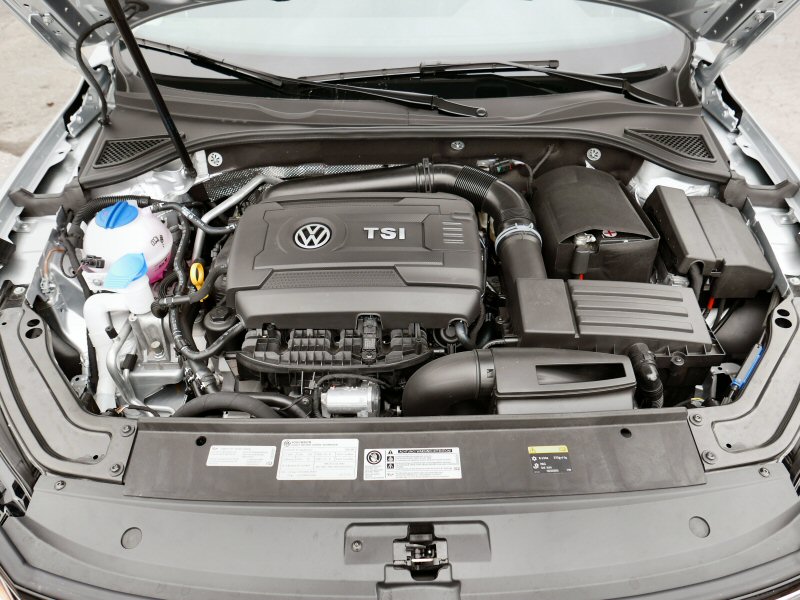
The 2016 Honda Civic is here to right some wrongs - specifically, the sub-par redesign that occurred in 2012 that precipitated a hasty, but significantly-improved do-over the year after. New from the ground up, the completely redesigned Honda Civic is intended to once again take on all comers in the battle for entry-level compact sedan dollars, giving up not an inch on style, comfort, or efficiency to its rivals. After having spent a day behind the wheel of the revised Civic, it's clear to me that Honda hasn't made the same mistake twice. Although not as exciting as some of its competitors, nor as plush as others, the 2016 Civic's overall package should have no issue cementing its traditional spot near the top of the small car sales chart.
Stronger Focus On Styling
One of the more common complaints made about the previous-generation Civic was its tendency to blend into the crowd of similarly-styled compact sedans. The 2016 Honda Civic makes new, bolder moves in the direction of automotive fashion, with even its most affordable models presenting a purposeful snout bisected by a thick chrome bar and framed by attractively-detailed headlights. In profile there are certain colors that reveal the Civic's busy lines better than others, but the hint of aggression is there and is continued at the rear where a new tail light design (which Honda calls a 'light pipe') keeps things interesting to the eye. It also helps that the car is about one inch lower and two-inches wider than it was before, giving the sedan road presence that was lacking in the older model. LED headlights are available to dress up higher Civic trims, and LED tail lights also work to add a premium feel to the Honda's first impression. Although currently only a sedan is on sale, the Civic will eventually be offered in coupe and hatchback body styles, with the latter marking a return to the three-door form that was once a regular feature of the Civic family.
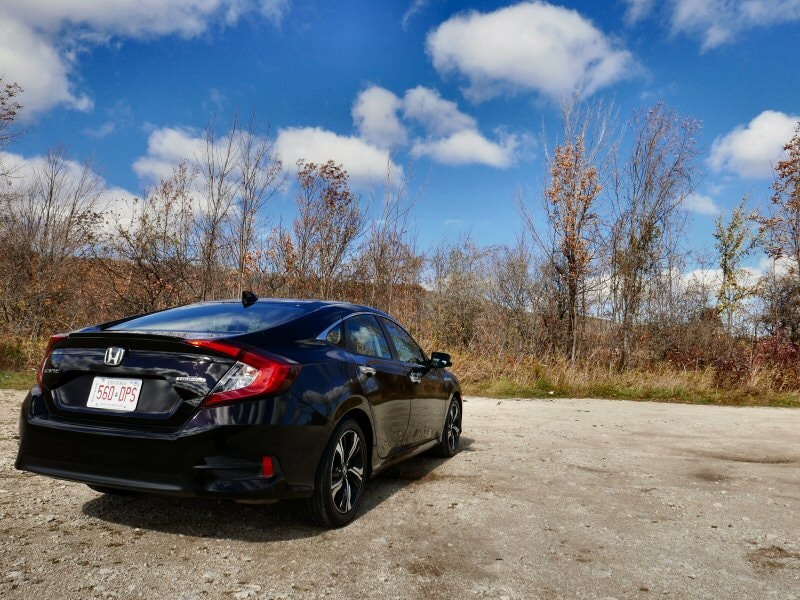
Photo by Benjamin Hunting
Bigger Cabin, Enormous Trunk
The extra width available from the 2016 Honda Civic's new platform is joined by roughly an inch of additional length, which is good news for anyone riding inside the sedan. There's just under four cubic feet of extra passenger room to be found within the Civic's cabin compared to 2015, which translates into 1.1 inches added on to the car's rear legroom as well as smaller boosts to driver legroom and headroom. Some of these changes came not so much from stretching the Honda's chassis, but rather a more clever method for organizing interior accommodations such as shrinking the bottom of the dashboard. I also liked the sliding console lid / armrest offered with the sedan, and the deep and useful storage space organized just below it (although I was less enamored of the driver-only USB port placement at the front of the car, shielded from the passenger by the lower reaches of the console itself). Trunk space is massive for such a small vehicle: 15 cubic feet are available in the Civic, a number that wouldn't look out of place in the mid-size segment.
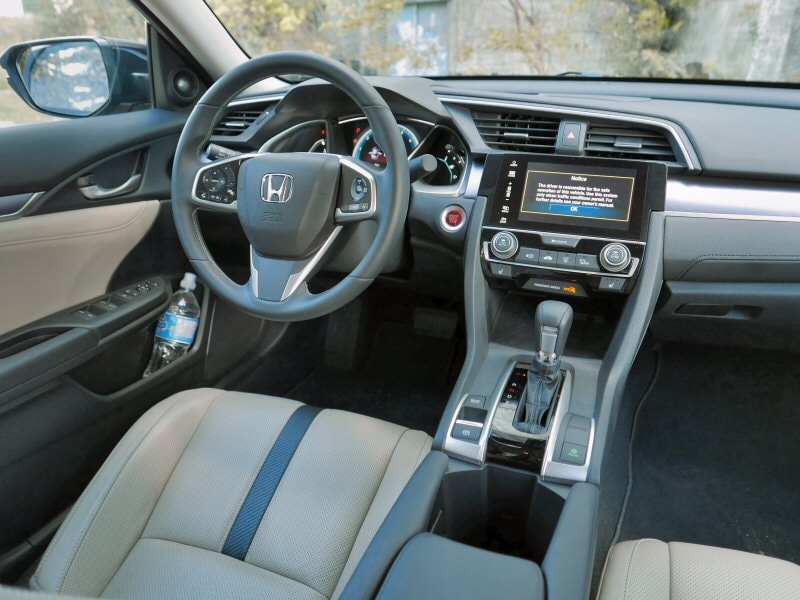
Photo by Benjamin Hunting
Smooth, Quiet Ride Prioritized
Acknowledging that it cut corners when it came to the quality of the materials and overall construction of the vehicle the 2016 Honda Civic replaces, extra effort was made by the automaker's design team in the execution of the current model. This has translated into a surprisingly quiet and composed experience behind the wheel, one devoid of the wind noise at highway speeds that I've come to expect from more affordable automobiles. The Civic's ride is also smoother than it has any right to be, although this comes at the expense of any amount of sporty feel from either the steering or the chassis itself. The Honda gracefully leans through the corners to gently remind you not to ask too much of its suspension setup, and in return it grants you a reprieve from the harsher elements of whatever road you happen to be traveling down. There's a definite gap between the respectable interior plastics and brightwork of the pricier Civic editions and the somewhat more drab base model. It's not a chasm, however, and overall there's not much to lament about the softness of the materials you end up touching, or the position of most of the car's controls, save for the irritating lack of a volume knob on any vehicle equipped with the brand's Display Audio touchscreen. Even on the steering wheel you're forced to use a touch-sensitive slider, which is marginally less maddening than tapping the volume icon on the LCD head unit over and over until you've reached the desired state of loudness.
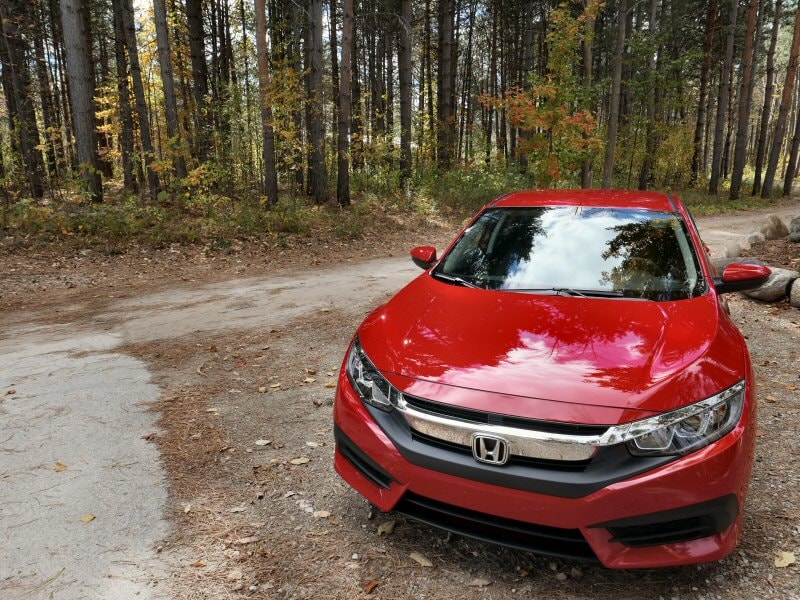
Photo by Benjamin Hunting
Two Brand-New Engine Choices
The most exciting news for Civic fans is the availability of a pair of fresh choices under the hood for 2016. The redesigned Honda Civic has ditched last year's 1.8-liter mill (which can still be found pulling duty in the subcompact HR-V crossover) in favor of a new 2.0-liter base motor that puts out 154 horsepower and 138 lb-ft of torque. Those familiar with the history of this compact sedan will no doubt notice that this 2.0-liter is the mightiest standard engine to have ever been offered with the Civic, and it can be paired with either a six-speed manual or a continuously-variable automatic transmission. Additional grunt is available in the form of a 1.5-liter turbocharged four-cylinder - a first for the Civic brand and in fact for Honda America in general, which has long been loathe to offer forced induction with any of its production models. The end result is a pleasing 174 horses and 162 lb-ft of twist, numbers that arrive with little drama thanks to the decision to make the CVT gearbox standard with the turbo model. The difference out on the road between the two cars isn't great as their disparate torque ratings might suggest. In fact, in a straight line, the turbocharged CVT is only slightly quicker than the six-speed 2.0-liter, and both are just fine in everyday driving (if a little drone-ish in steady-state cruising with the continuously-variable setup). I was somewhat surprised to see Honda forgo a manual mode of any kind with its automatic transmission, but company representatives assured me that should a demand for a traditional shift-it-yourself gearbox for the turbocharged Civic arise, then there is nothing stopping them from dropping one in.
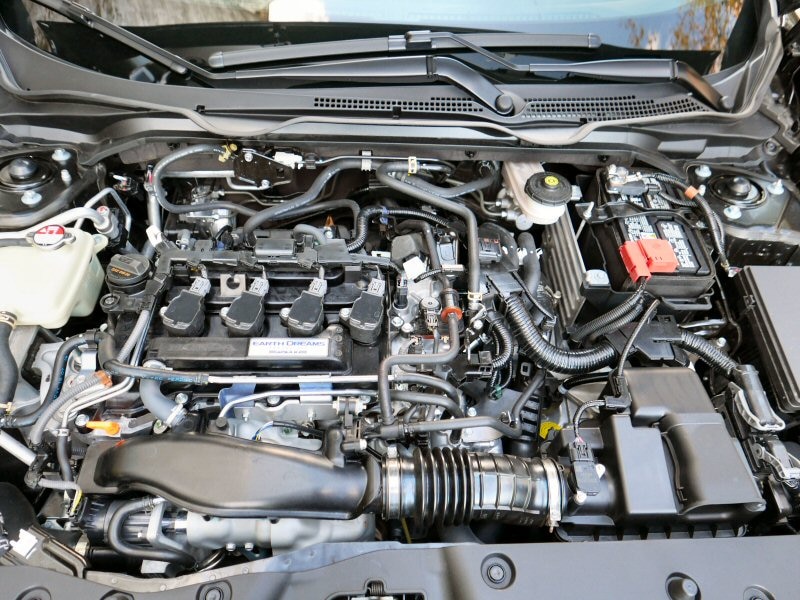
Photo by Benjamin Hunting
Exceptional Fuel Efficiency Across The Board
There's really only one loser when it comes to efficiency when examining the 2016 Honda Civic: the six-speed base car, which posts a middling 27-mpg around town to counterbalance its 40-mpg highway rating. The rest of the line-up leverages the Civic's CVT to post brilliantly frugal performances, with the automatic 2.0-liter showing 31-mpg city and 41-mpg highway and the more robust 1.5-liter turbo mill matching that around-town figure and upping the ante to 42-mpg during highway cruising. You really don't have to choose between power and mileage when selecting which version of the Civic you should park in your driveway, but perhaps more importantly even the entry-level engine is capable of sipping fuel at a relaxed rate without forcing you into the pricier turbocharged model like a number of other compact cars do.
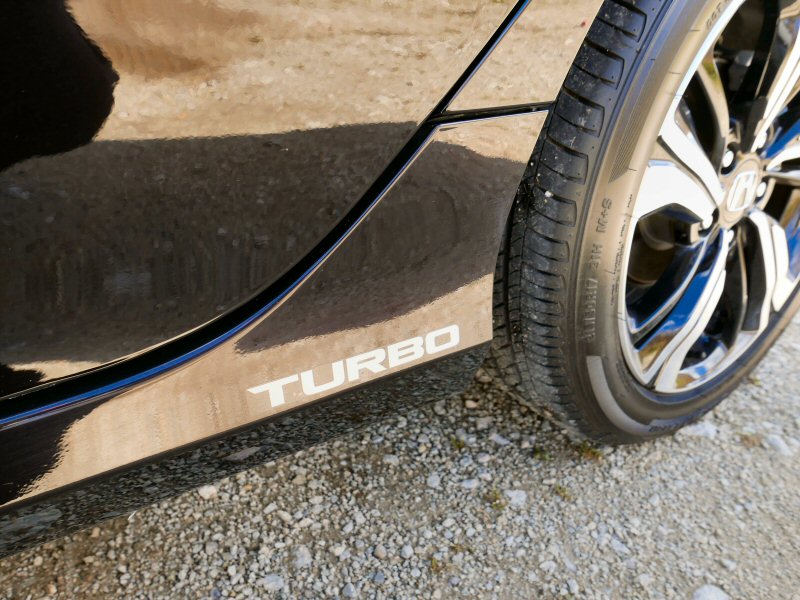
Photo by Benjamin Hunting
Upscale Features, Advanced Safety Take Center Stage
Part of rehabilitating the 2016 Honda Civic's image amongst crestfallen devotees stuck with 2012 models has been to vastly expand the level of equipment offered with the car. While some of this takes the form of the previously-mentioned Display Audio system (what with its Apple CarPlay and Android Auto capabilities), more impressive to me was the availability of high-end safety gear not often seen in such a small, inexpensive automobile. The Honda Civic offers features such as an adaptive cruise control system, forward collision warning with automatic braking capability, and even a lane keeping assistance feature that automatically steers the car to keep it between the yellow and white lines on the pavement. This is an absurdly high standard of gear to make available on what is essentially an entry-level car, but even more surprising is that it's not restricted to the priciest model in the line-up, as the required Honda Sensing package can be ordered across almost all trim levels (so long as they're equipped with the CVT). One piece of safety gear offered by Honda that I wish had been left on the shelf is the LaneWatch system. LaneWatch can be thought of as the answer to the riddle 'how can we make blind spot monitoring more intrusive, less useful, and only on one side of the car.' If this seems like a question no one was really asking, then you're right, but here we are. Honda's LaneWatch uses a camera mounted on the passenger-side mirror to show a view of the lane immediately to the right of the car every time the blinker is activated. And I do mean every time, which can be a real hassle when you're sitting at a traffic light suddenly unable to see the navigation screen because the LCD has been taken over by the camera feed. I also find it distracting to have to take my eyes off of the road to see an image located down and to my right rather than simply use an audio chime or line-of-sight LED to alert me to potential blind spot traffic - on both sides of the car, please.
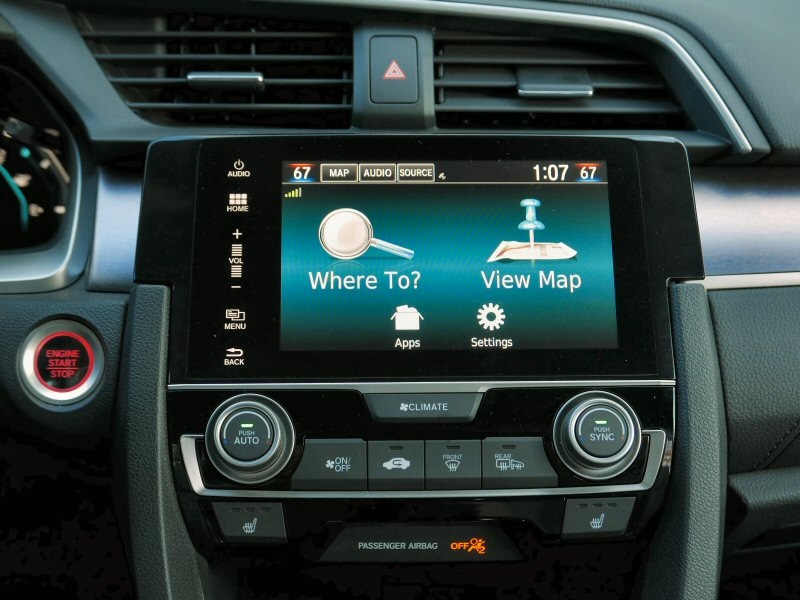
Photo by Benjamin Hunting
You'll Pay A Little More For This Honda
The 2016 Honda Civic starts at an MSRP of $18,640, which places it higher than comparable base models from companies like Ford (the Focus), Toyota (the Corolla), and Mazda (the Mazda3). Honda claims that the Civic's list of standard features helps make up at least some of the difference between its window sticker and the asking price of certain competitors, but there's also the fact that the automaker is willing to tie its value equation to reliability and engineering excellence rather than a bargain monthly payment. You'll have to shell out $26,500 for the Honda Civic Touring that sits at the top of the pyramid, which comes with the 1.5-liter turbo engine and CVT transmission.
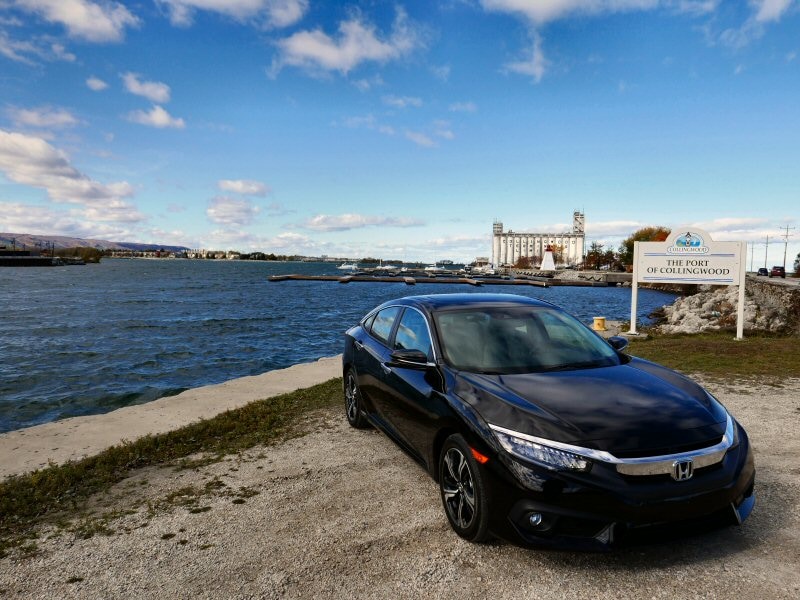
Photo by Benjamin Hunting
Honda Civic Si and Civic Type R Editions Are On The Way
With good, but unexciting acceleration combined with competent yet equally placid chassis tuning, one might despair that the 2016 Honda Civic sees the brand heading further away from the engaging character that once defined at least a handful of its affordable models. Fear not, for while the bread-and-butter Civic might not stimulate the senses when pushed to the limit, there are not one, but two high-performance editions on the way from the Japanese brand. The first is the stalwart Si. Once a high-revving thriller, in recent years the Civic Si has traded lofty rpms for displacement and in the process lost a hefty chunk of its identity - a trend that Honda may be looking to reverse with the clean-slate platform it now has in its pocket. Expect something close to 200 horsepower, if not a little more, and a manual transmission for the upcoming replacement Si. If you're looking for a faster rush of adrenaline, then you'll find it in the Civic Type R, which will leverage the brand's newfound taste for turbocharging to produce more than 300 horsepower from a 2.0-liter four-cylinder engine. An American version of the long sought-after model is guaranteed for this peppiest of Honda compacts, where it will do battle with the likes of the Ford Focus RS, the Volkswagen Golf R, and the Subaru WRX STI.
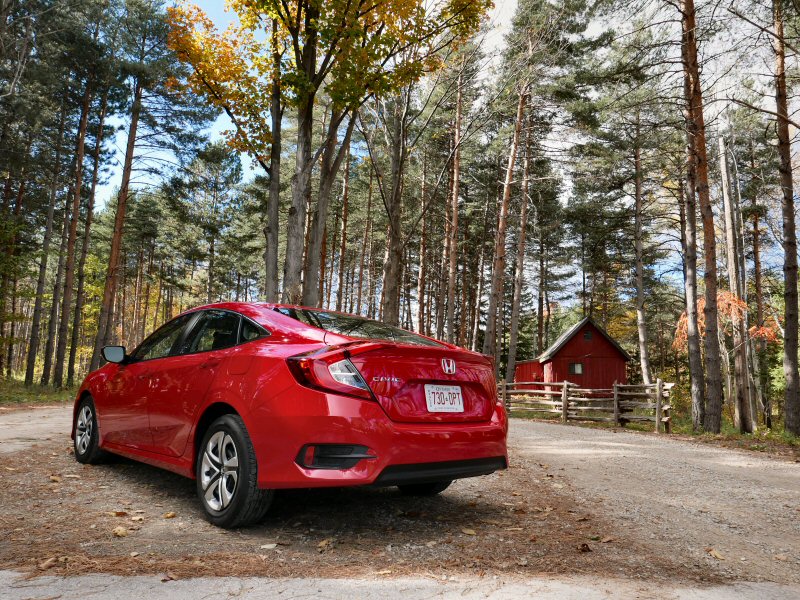
Photo by Benjamin Hunting
Pros / Cons
Pros: • Significant styling improvement • Larger, quieter interior • Comfortable ride • Some of the best active safety equipment in its class • Two new, fuel-efficient four-cylinder engines • Upcoming Si and Type R models hint at a return to performance for the brand Cons: • Affordable, but not the most affordable compact car on the market • Not as fun to drive as Ford Focus or Mazda Mazda3 • No volume knob = incredibly frustrating • LaneWatch is obtrusive and limited in its utility

Photo by Benjamin Hunting